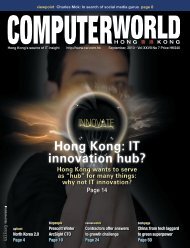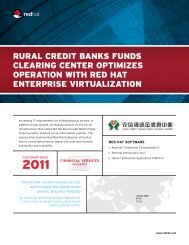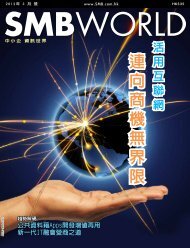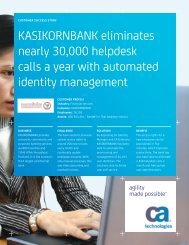Hong Kong Computer Society - enterpriseinnovation.net
Hong Kong Computer Society - enterpriseinnovation.net
Hong Kong Computer Society - enterpriseinnovation.net
Create successful ePaper yourself
Turn your PDF publications into a flip-book with our unique Google optimized e-Paper software.
Sponsored Feature<br />
Since 90% of the content will be the same<br />
each day, it is a major advantage if your<br />
system can execute de-duplication of the<br />
contents. Volumes of email can typically<br />
be reduced by 30% by removing duplicated<br />
attachments and identical documents circulated<br />
to many addresses, for example.<br />
Databases can be reduced by up to 90% of<br />
their volume. Using de-duplication technology<br />
reduces storage volume and costs and<br />
speeds retrieval.<br />
Disaster recovery<br />
Another crucial need is for a disaster<br />
recovery strategy to ensure that a usable<br />
copy of the enterprise data is available if<br />
the primary site is completely unavailable<br />
for any reason. Relying on a tape archive<br />
is inviting problems – tapes may so easily<br />
be lost, stolen or destroyed and even when<br />
they are available, restoration of service is<br />
slow.<br />
Today large or small enterprises should<br />
look into real-time data replication on<br />
disk, linked with telecom lines. The ideal<br />
is real-time mirroring, using a system<br />
such as the IBM SVC (SAN Volume Controller),<br />
an appliance that can virtualize<br />
different brands of disks for data mirroring.<br />
Enterprise and mid-range solutions<br />
are also available.<br />
There are three storage tiers commonly<br />
used for enterprises:<br />
Tier 1: Continuous, online, transactional<br />
data mirroring.<br />
Tier 2: Flashcopy, a snapshot technology,<br />
which can easily protect data at intervals<br />
of an hour or less, with recovery in the<br />
same period. Suitable for applications such<br />
as email and database, for example.<br />
Tier 3: Basic restore within one day, or<br />
suitable for long retention restoration requirements.<br />
The security of data at rest<br />
Most enterprises are tackling <strong>net</strong>work<br />
data security fairly actively, but numerous<br />
serious security breaches result from the<br />
theft or loss of ‘data at rest’ on tape cartridges,<br />
USB thumb drives, notebooks and<br />
disk drives removed for service. Even PCs<br />
or servers can disappear from data centers<br />
on occasion. The most common such<br />
problem arises with routine servicing of disk<br />
drives or when they are removed for redeployment<br />
or retirement. Although we like to<br />
trust service vendors that handle storage<br />
www.cw.com.hk<br />
Tier 1<br />
Systems can provide full<br />
data mirroring and higher<br />
read and write performance:<br />
<br />
series<br />
<br />
series<br />
<br />
<br />
<br />
<br />
devices, once a drive is removed from the<br />
storage appliance, it is impossible to guarantee<br />
that its content will not fall into the<br />
wrong hands.<br />
It is difficult to permanently delete the<br />
data on a hard drive. Degaussing (mag<strong>net</strong>ic<br />
obliteration) is expensive and troublesome,<br />
while physical destruction of the disk is obviously<br />
not appropriate if it is intended for<br />
re-use. The disk can be stored indefinitely<br />
by the owner, but this will also prevent its<br />
re-use.<br />
A complete solution is now available in<br />
52% of managers don’t have confidence in their<br />
enterprise data, while 59% admit to missing vital<br />
information.<br />
the form of self-encrypting disks. These devices<br />
encrypt all stored data as it is written,<br />
and decrypt all content as it is read, without<br />
any external application or encryption key.<br />
This means when the drive is removed for<br />
servicing, redeployment or retirement, the<br />
data on it cannot be read by any party. IBM<br />
experience is that 90% of drives returned<br />
for warrantee service have readable data<br />
on them. Nor can the drive be installed in<br />
any other hardware, unless it is reformatted<br />
in a secure way which absolutely destroys<br />
the current data.<br />
Most important, the encryption and decryption<br />
processes are completed with<br />
no performance overhead whatsoever.<br />
One of the largest reasons why enterprises<br />
users resist encryption is that<br />
conventional encryption methods have a<br />
processing overhead that slows system<br />
performance for all applications. Self-encrypting<br />
disks use a different technology<br />
that eliminates performance loss and operation<br />
efforts.<br />
Data Availability Tiers<br />
<br />
Tier 2<br />
<br />
management:<br />
<br />
<br />
series<br />
<br />
series<br />
<br />
<br />
<br />
<br />
Tier 3<br />
<br />
<br />
<br />
<br />
System<br />
The outlook for self-encryption<br />
There is already a strong trend in place<br />
to protect ‘data at rest,’ including thumb<br />
drives, tapes and laptops and special technologies<br />
have been developed for that purpose.<br />
Part of the reason is compliance with<br />
government and professional regulations<br />
that require that data is protected using the<br />
best technology available.<br />
Most enterprises have suffered some<br />
cost or inconvenience related to the disposal<br />
of hard drives. Within one or two<br />
years, most users may adopt self-encrypting<br />
drives as a solution. The advantages<br />
are very real, while the additional cost is<br />
negligible, and there is no performance<br />
impact – the encryption process is transparent<br />
to users.<br />
IBM is already providing self-encrypting<br />
hard drives as an option with storage appliances<br />
such as:<br />
• DS5000 Mid-range series and<br />
• DS8000 Enterprise class storage<br />
servers<br />
IBM’s self-encrypting hard drive also provides<br />
an ‘Instant Secure Erase’ function<br />
that enables users to safely redeploy disks<br />
with no possibility of readable data remaining<br />
on them. Early adopters are the finance<br />
industry, driven by compliance. It is likely<br />
that they will become standard in the enterprise<br />
environment over the next two or<br />
three years.<br />
Enrol for the IBM Information<br />
Infrastructure workshop on Nov 12 at:<br />
www.ibm.com/hk/events/DS5020/<br />
or contact Ms Yeung at<br />
2825 6140.<br />
Nov 2009 <strong>Computer</strong>world <strong>Hong</strong> <strong>Kong</strong> 15














